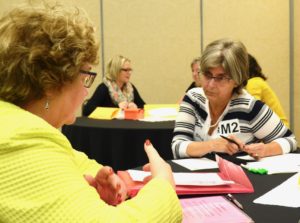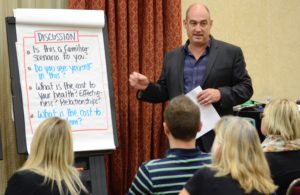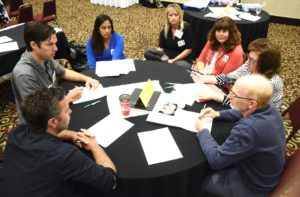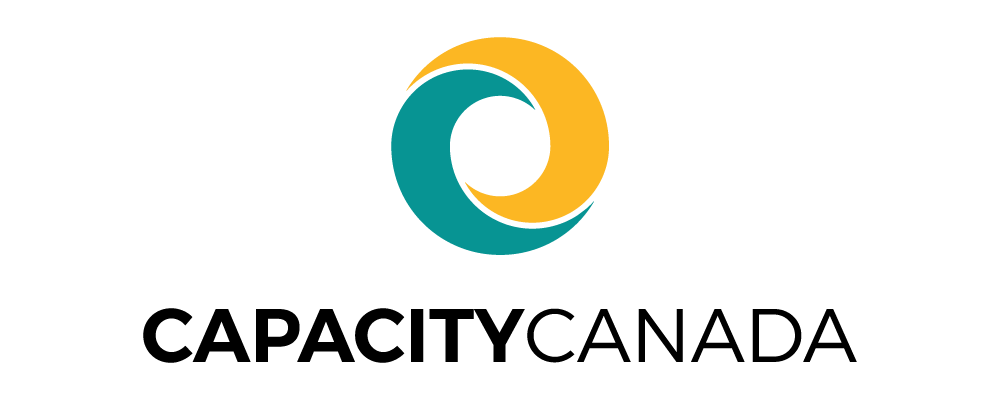|
Getting your Trinity Audio player ready...
|
What a week for Sharon Mayne-Devine, a middle manager at Creative Consultants Inc.
A customer needed a job done, but the “tops” — her bosses — had high-tailed it for a planning retreat. Front-line staff, meanwhile, felt put-upon and unappreciated. It probably doesn’t help that her company refers to them collectively as “ the bottoms.”

“I felt disempowered, ineffective and not having any influence on the tops,” said Mayne-Devine, a “middle’ in the corporate jargon used at Creative Consultants. “I was experiencing that feeling of being torn between the two levels.”
Just as Phil Cady expected.
An expert in organizational systems — why some work and other don’t — Cady led a leadership development workshop Oct. 6 at the Kitchener Holiday Inn.
Capacity Canada hosted the event to mark Worldwide Week of Partnership, in which Cady and other professionals offer their time pro bono.
Mayne-Devine’s sense of being pulled in different directions by forces seen or unseen, said Cady, is just the sort of organizational turmoil that Boston-based Barry Oshry has studied for decades.
Cady is a proponent of Oshry’s Power+Systems approach to leadership development, one that shrinks hierarchical barriers, builds empathy among employees and makes people feel they have a shared responsibility for the well-being of the workplace social system.

“The definition of partnership is central,” Cady said in an interview after the workshop.
“Are we in a relationship where we are jointly committed?
If we are, then new possibilities open up . . . Curiosity, openness are a couple of central features (to organizations that function well).
“It’s part of the human condition that we want to do good work and have healthy relationships.”
Cady, founder and president of his own leadership consultancy, CLSWEST Inc., started the day by organizing the workshop’s 19 participants, most from area not-for-profits, into a company.
The executive director of Catholic Family Services — Peel-Dufferin, Mayne-Devine found herself as a middle manager in Cady’s imaginary Creative Consultants Inc. (CCI). The company’s week was a series of five, 13-minute “days.”
CCI had money, customers, and a rigid, traditional structure. Tops ruled, bottoms couldn’t engage with the middle and top ranks without permission, and middles brokered the needs of the tops and bottoms.
Customers, meanwhile, added “turbulence” by approaching the company with projects they wanted thought out and completed.
“What was happening? Chaos was happening because there was no clear, organizational structure,” Mayne-Devine said. “I found myself wanting to gravitate to serving the customer before I was actually ready to help the customer. I was being very reflexive.”
During the day-one debrief, Cady asked participants to pay close attention to words used to describe their feelings.
Customers talked about being frustrated, middles about loss of control, bottoms about distance and disconnect, and tops about feeling responsible, in the buck-stops-here sense, for the confusion.
Things improved over the next four, 13-minute days. Tops came back to add leadership and build strategy. The need for better idea flow brought down troublesome hierarchical barriers separating tops, middles and bottoms. Customers felt the company was finally making progress on their projects.
Meaningful change, Cady said, occurs when all parties involved switch perspective to see things from the point of view of the customer or somebody ranked at the bottom, middle or top of an organization. These periods of reflection build an empathetic understanding of how an organization functions.
Participants in an organization also need to stake a claim in its success. Tops, Cady said, should create responsibilities for others to share, instead of always sucking it up for themselves.

Middles can serve as the reality check for the tops, “speaking truth to power” about the organization’s real ability to meet goals set from above.
Instead of seeing themselves as powerless victims, bottoms might own some responsibility for the system in which they work, and shift their footing from “complaint to possibility.”
Rather than simply judge its failings, customers can become more engaged in how a company’s delivery system works.
Later in the workshop, participants shared on-the-job challenges they face, from website changes to building team morale. Cady broke the group into smaller units and had participants briefly pitch their challenges, tuning the pitch for the ear of a customer, or bottom, middle or top employee.
Mayne-Devine’s week as a stressed middle manager for a made-up company ended at noon. Out of it, she said, she gained a new appreciation for the importance of making time for reflective thought and connecting with staff.
“It gives me a framework or a map on how some of the folks are feeling in those middle roles,” she said. “And it affirms some of my instincts.”

